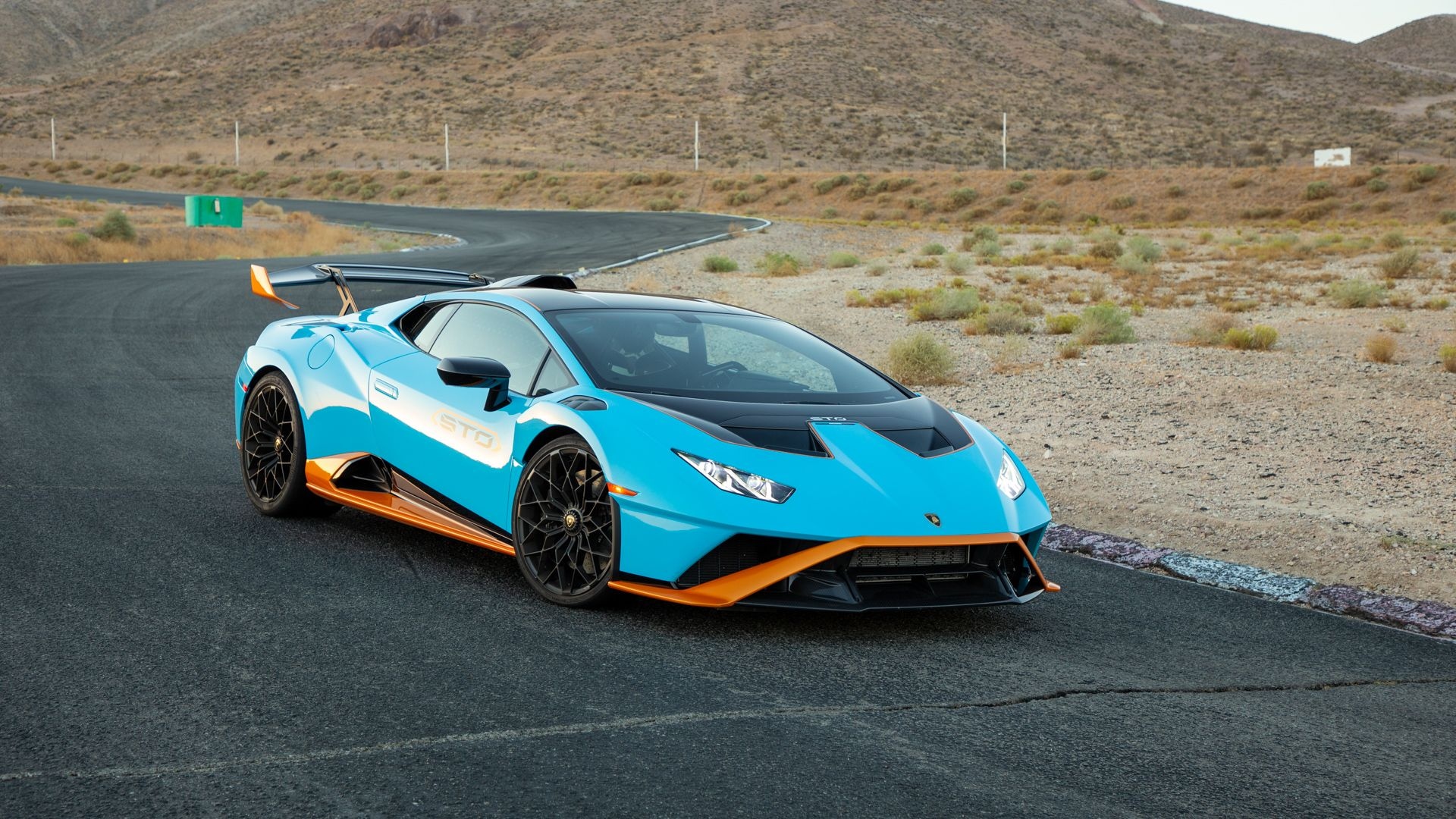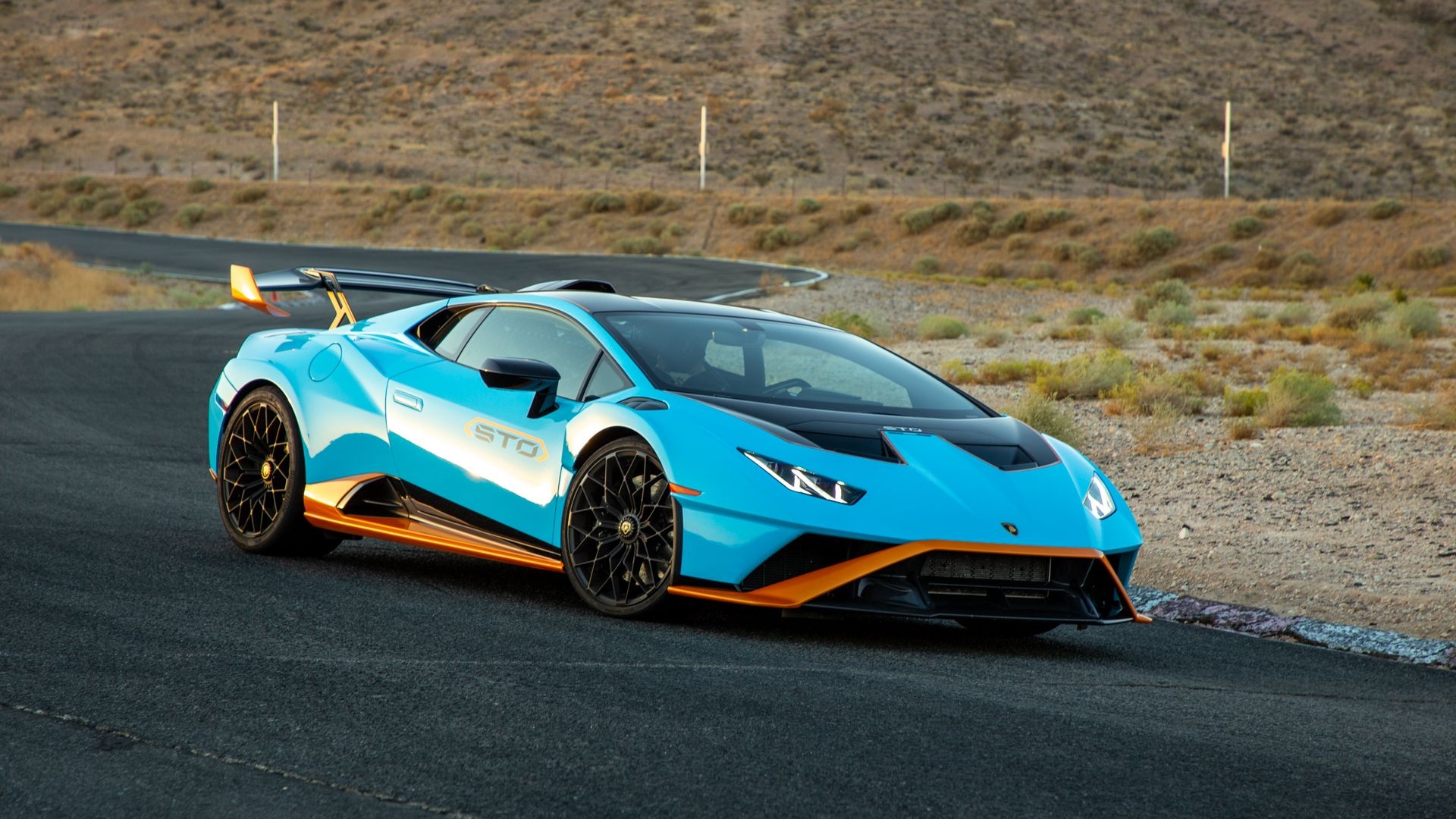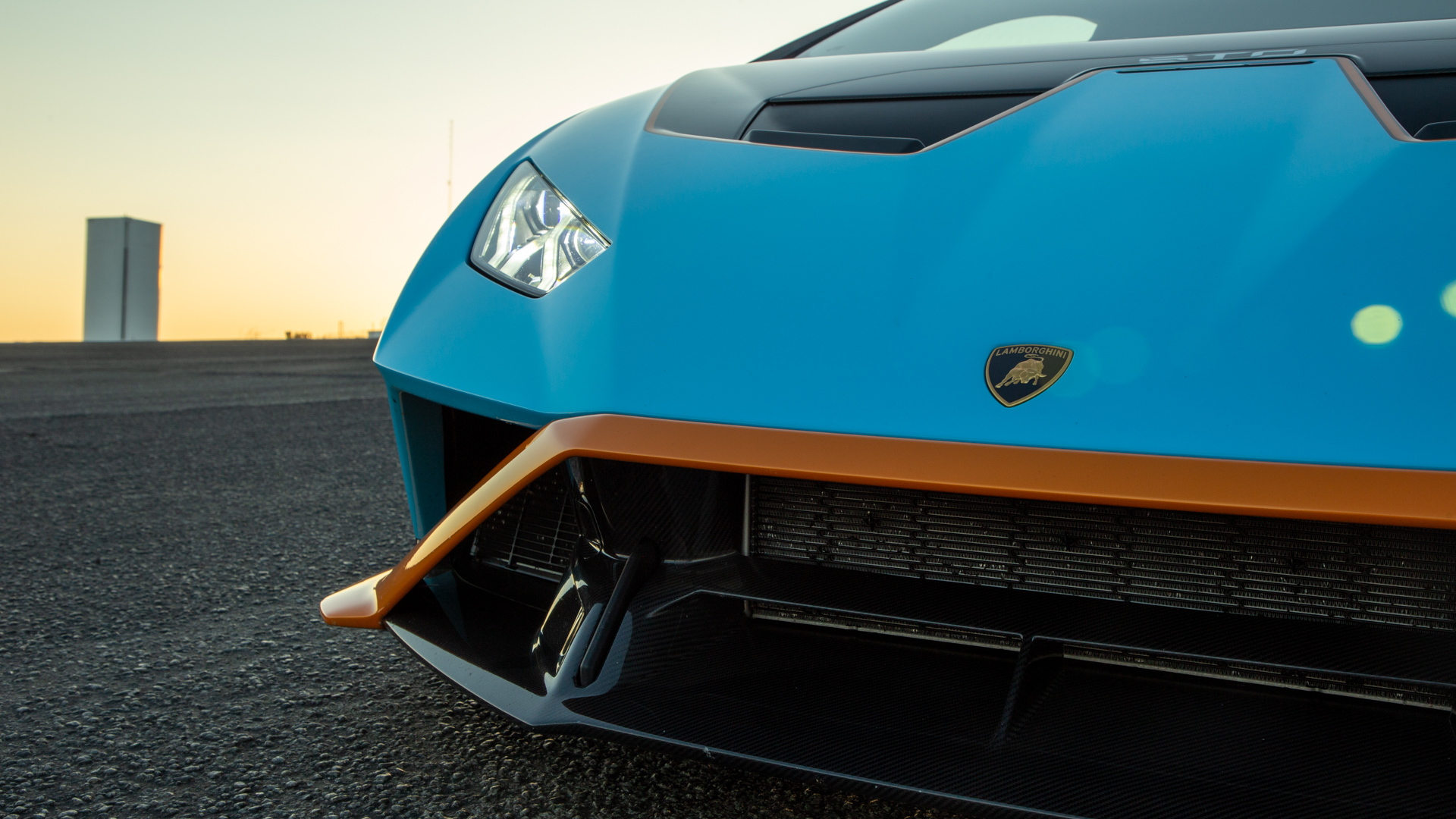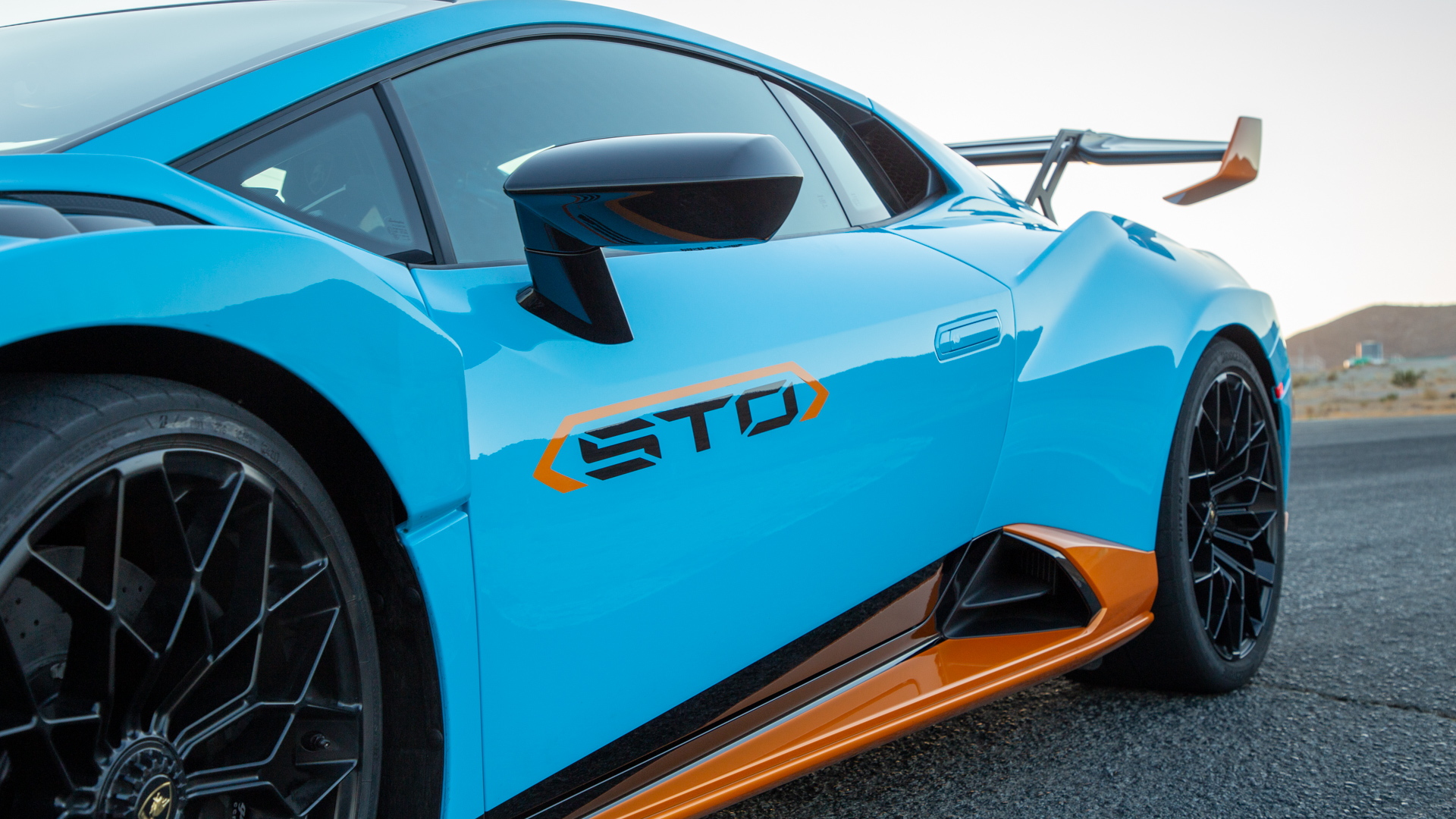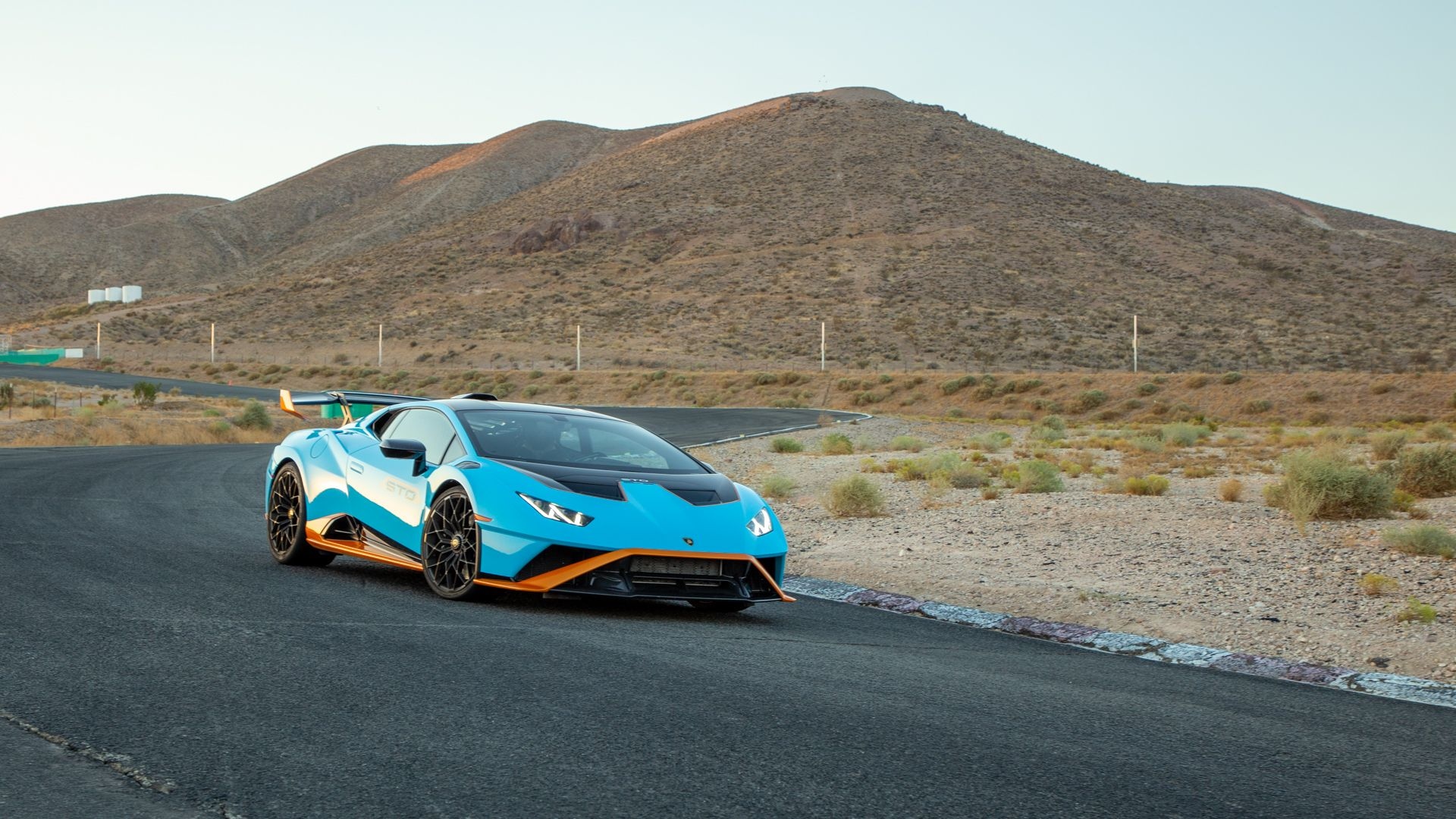The 2021 Lamborghini Huracán STO’s expansive set of digital instruments can tell me just about anything, including the brake temperatures at each wheel. There’s one thing missing, however: a heart rate monitor. As I sit in the driver’s seat getting ready to roll out for hot laps around Willow Springs International Raceway in California, my heart feels like it’s palpitating at about 193 beats per minute to match the STO’s top speed. As I start taking deep breaths to calm down, I get the ready signal and fire up the V-10, which comes to life with a roar...there goes my heart again.
Even though I’m quite familiar with this track, my nerves are getting to me because of the advanced piece of machinery I’m sitting in. The STO, short for “Super Trofeo Omologata,” is as close as a street legal car can come to a GT3 racer. “Omologata” translates to homologation in English, and Lamborghini says that the STO is “designed to split the experience between a race car and a street car.” On the high-speed curves of Big Willow, it ends up feeling more like the former.
That’s not surprising, given that the STO is derived from Lamboghini’s racing Huracáns, the Huracán Super Trofeo EVO and the Huracán GT3 EVO, the latter of which won the 24 hours of Daytona from 2018-2020. Lamborghini says it tested the STO around Daytona, where the Huracán GT3 EVO put up a 1:46.40 on slicks. The Huracán STO was just about two seconds behind that at 1:48.86 on street-legal tires, and when asked if the STO would put up a similar time on slicks Maurizio Reggiani, Lamborghini’s chief technical officer, grinned and said “I don’t think I’m allowed to tell you that but…”
Lamborghini gives me four four-lap sessions on the track, and each concurrent set of laps reveals something new to appreciate about the car. Starting with its power.

2022 Lamborghini Huracan STO

2022 Lamborghini Huracan STO

2022 Lamborghini Huracan STO
Session 1: Who needs all-wheel drive?
The STO shares its engine and transmission with the Huracán Performante, combining a 630-hp, 5.2-liter V-10 that makes 417 lb-ft of torque with a 7-speed dual-clutch automatic transmission. This gives the car outrageous acceleration figures: 0-62 mph in 3.0 seconds and 0-124 mph in just 9.0 seconds. The naturally aspirated V-10 also sounds absolutely incredible, with that distinct Lamborghini tone that starts low and growly, before it opens up into a full on wail from 6,000 rpm to the 8,500 rpm redline. It’s addicting whether you’re in the car or outside watching it fly by.
Unlike the Performante, which splits that power between four wheels, the STO sends all of it to the rear. The prospect of sending 630 hp to only two wheels in a car that’s lighter than a Lotus Evora gave me pause that inspires me to baby the throttle at the start of the laps. I keep the car in its STO drive mode, the default mode that is the only one of the three drive modes to offer automatic shifting. Both Trofeo and Pioggia require the driver to change gears.
It becomes immediately apparent that the automatic mode is not the way to go, the shifts are fast but it feels a step behind on the track. It’s clearly a mode meant for moving around town, the manual mode is far better out here. The paddle shifters trigger instantaneous upshifts and downshifts and give the driver much more control. As the third lap begins I start to build up more confidence because the STO feels incredibly stable on throttle.
That’s thanks in large part to the STO’s aerodynamic features. Up front, a single-piece “cofango,” a combination of the Italian words for hood and fender, is crafted from carbon fiber and has air ducts that create downforce and route air to the central radiator. At the rear is a large, manually adjustable swan-neck rear wing with three downforce settings; it produces up to 926 pounds of downforce at 174 mph in its most aggressive setting (I drove with the wing in this setting).
Those features provide a lot of downforce in the two areas that are key to a RWD car: the nose (for greater handling) and the tail (for greater traction). That helps the STO to put its power down cleanly, especially when pouring onto the throttle at Willow Springs, which has three different places to go full throttle at for a sustained period.

2022 Lamborghini Huracan STO
Session 2: Fixed ratio is the way to go
As I climb into the car for the second set of laps, my confidence is growing as are the speeds and the importance of setting up the car properly for each corner. That gives me a greater appreciation for the STO’s impeccable handling and stability.
I click the Huracán STO into Trofeo mode for this set of laps, which bumps up the throttle’s responsiveness, stiffens the suspension, and loosens up the traction control. (The STO’s third drive mode, Pioggia, is optimized for wet roads.) But one thing that it doesn’t change is the steering—the 13.4:1 ratio is fixed across all of the drive modes.
The STO’s steering has much more stiffness and weight than you’d find on a normal vehicle. That’s very much appreciated because it’s an incredibly fast steering rack that’s clearly been set up for the track. It takes a bit of time to get used to the quick ratio. Seemingly minor inputs cause the car to abruptly change the orientation of the nose, but the system is super accurate and it teaches you to be intentional behind the wheel. By the second session, I’m comfortable and confident with it.
The electromechanical system has the direct feeling of a hydraulic rack, providing a great amount of feedback and instant responsiveness to driver inputs. Combined with the downforce over the nose, you can really fling the nose into a corner and it remains planted with no detectable understeer.
The Huracán STO is also the first Lamborghini with Bridgestone tires, replacing the usual Pirellis. The Bridgestone Potenzas are offered in sport or race flavors with sport tires offering greater durability thanks to a harder compound that provides about 12,000 miles of life. My test vehicle is outfitted with the race tires that are much better in this setting, with less tread and a softer compound, but only about 6,000 miles of treadwear.

2022 Lamborghini Huracan STO

2022 Lamborghini Huracan STO

2022 Lamborghini Huracan STO
Session 3: Hitting a wall (not literally)
At the end of Willow’s long front straight is an uphill climb into a banked left-hand turn that requires you shave off around 60 mph. I’ve had the throttle pinned and the V-10’s roar is filling my ears with the speedometer tipping to nearly 160 mph. That’s about 10 mph faster than I’d been going on the previous laps so I hit the brakes with more determination and find myself flung forward against the seatbelt.
As impressive as the Huracán STO’s acceleration is, the brakes are a real showstopper. The STO features F1-derived Brembo CCM-R (carbon ceramic material race) brakes that aren’t found on any other production vehicle. The braking system provides four times more heat resistance and a 25% increase in braking power compared to traditional carbon-ceramic brakes.
The increase in braking power is immediately noticeable. Though the pedal feel is predictable and linear, it’s important to be as careful with the brakes as the throttle. Stab at the pedal and they grab really hard, enough to upset the balance of the car. Once I get it down, I appreciate the added stopping power, which allows me to brake later into turns, and that means faster lap times.
The track also highlights the brakes’ durability. I’m in the last track session of the day for the drive event and the cars had been running hot laps all day in roughly 90-degree weather. After my 16 hot laps, the brakes donn’t even turn from green to yellow on the brake temperature screen and there is no detectable fade or change in feel/performance.

2022 Lamborghini Huracan STO
Session 4: Putting it all together
Through my time on the track, I begin to trust the Huracán STO more and more. My initial trepidations have ebbed away and my heartbeat slows, even as the laps get faster. In the fourth session I’m feeling a level of comfort that I didn’t think I’d find in the STO. For such a track-focused machine, it feels very approachable. Everything works in such splendid harmony; the aerodynamics, the ultra-responsive steering, the powerful brakes, and of course that wailing V-10 in the middle.
The Huracán STO eggs you on to push it harder and the car rises up to meet the added speed with confidence-inspiring precision. A ride-along with one of Lamborghini’s endurance racing drivers at the end of the day shows I didn’t come close to maximizing the car’s potential, but I did come to adore the STO’s surprising predictability and stability. It’s a nearly perfect track machine.
The Huracán STO costs $333,633 (including destination and GGT charges) in the U.S. and is technically available now. However, Lamborghini says orders are sold out through October 2022, so it will be a long wait. And please, if you do end up with one, let it out on a circuit every once in a while. Beasts like this weren’t meant to be caged.
Lamborghini provided a day at the track, two test vehicles, and a professional racing driver to chase for Motor Authority to bring you this firsthand report.
